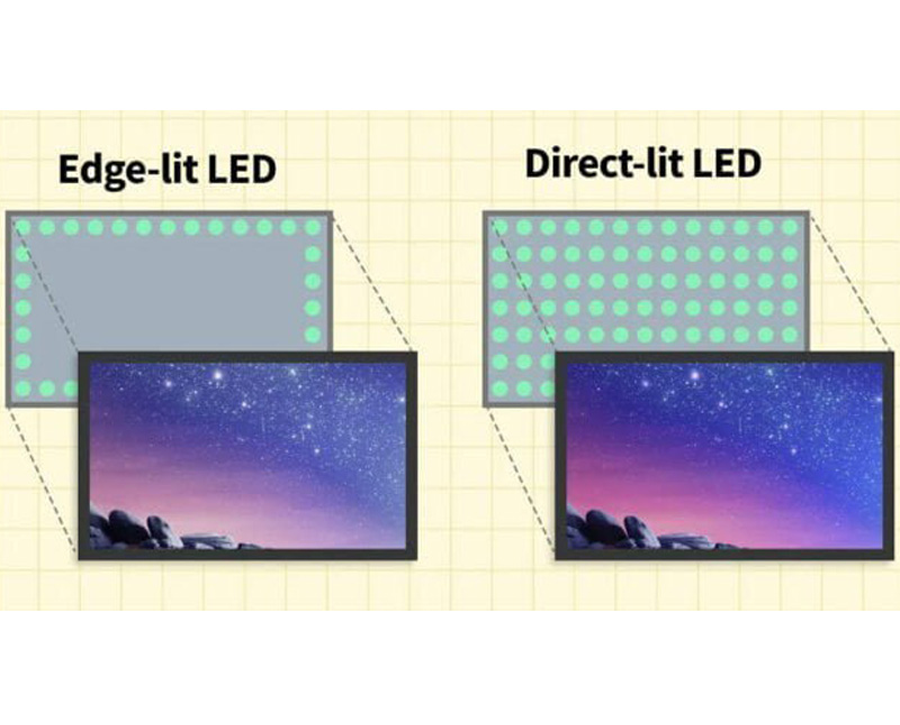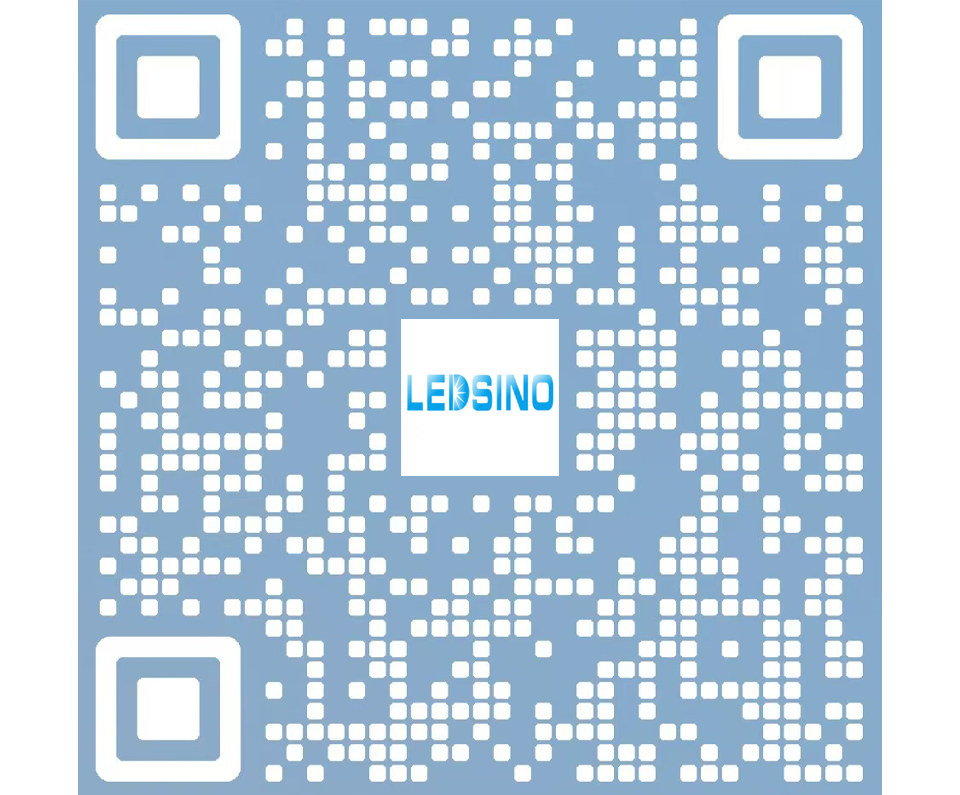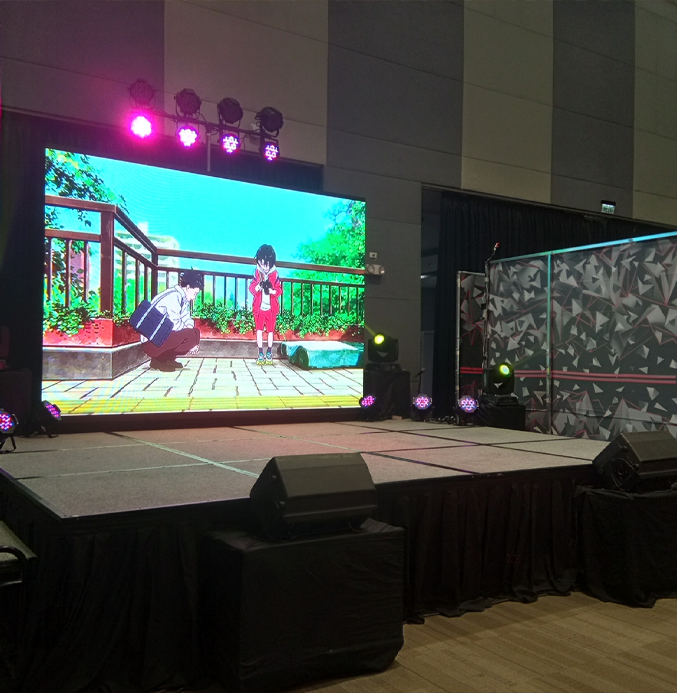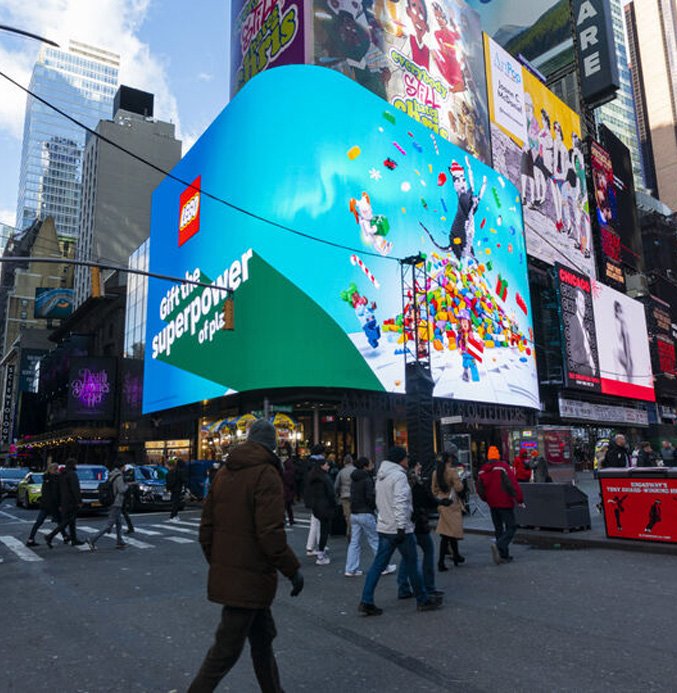
Selecting the right LED display can be daunting since a wide range of options are available. Among the popular options, you have the edge-lit and the direct-lit LED displays. You are going to learn all about the technologies to help you make your choice.
What is An Edge Lit And A Backlit Screen?
To understand how edge-lit and direct-lit LED displays work. You need to understand how the technologies work and how they differ in structure.
Edge-lit LED screens use LEDs along the edges of the screen. These LEDs emit light that is then channeled across the screen with the aid of a diffuser plate. The diffuser spreads the light evenly, ensuring the screen is well lit. This configuration enables thinner and lighter displays. However, since light needs to travel from the edges to the center. There is a possibility that some inconsistencies in brightness may arise or even light bleeding. This setup is commonly used in modern slim TVs and monitors.
The working of direct-lit LED screens is different. In these displays, the LEDs are located right behind the display panel, lining up on its entire back surface. The design ensures consistent and even light distribution because the source of light is aligned right with the screen. It increases brightness and contrast to show bright and vivid, yet uniform images. On the other hand, it makes the direct-lit displays bulkier and not sleeker compared to the edge-lit designs.
These fundamental structural differences drive the performance, application, and cost of edge-lit and direct-lit displays. Both are based on LED backlighting but serve different needs based on their use case.
How Edge-lit And Direct-lit LED Displays Differ
A number of differences exist between edge-lit and direct-lit LED displays. Knowing the differences will lead you to which technology meets your needs.
One of the main differences is brightness. In this respect, direct-lit displays have an advantage because their LEDs are evenly distributed right behind the screen. This configuration allows for higher brightness levels and more uniform illumination. Edge-lit displays cannot achieve the same brightness uniformity since the light source is at the edges, and the light has to make a longer journey to the center.
Another critical area in which these technologies contrast performance wise is that, normally, direct-lit displays will have localized dimming. This means it is possible to dim or increase brightness in certain areas of the display. This usually has deeper blacks and increases contrast ratios. Edge-lit, although capable of decent contrast. Generally falls short in both precision and depth. Especially when compared to the exactness that can be reached by direct-lit technology.
Power consumption is different between the two. The fact that edge-lit displays use fewer LEDs makes them more energy-efficient. Lower numbers of LEDs translate to a reduction in the demand for energy, which is cost-effective and eco-friendly. A direct-lit display uses a larger number of LEDs to achieve the superior brightness and uniformity, therefore consuming more power.
Slimness is where edge-lit displays truly shine. By virtue of their design, with LEDs placed along the edges, ultra-thin and lightweight screens are achievable. This makes them perfect for settings where sleek aesthetics are in order. On the other hand, direct-lit displays have their LEDs positioned right behind the panel and hence tend to be bulkier. While this does not detract from their performance. It can limit their versatility in certain setups.
Another point of difference is the price. Being less complicated in design, edge-lit displays often are cheaper because they don’t require as many elements. Correspondingly, direct-lit displays with better quality and a range of advanced features-including localized dimming. Represent the higher price end. Thus being less accessible to budget-conscious consumers.
Lastly, the manufacturing process differs. Edge-lit displays require precise placement of LEDs along the edges and advanced diffusers to ensure even light spread. Direct-lit displays involve a straightforward but material-intensive process, given the larger number of LEDs required.
These differences underline the strengths and weaknesses of each technology. Making it essential to weigh your priorities when choosing between the two.
Pros and Cons Of Edge-lit LED Displays
It provides several advantages that have made them quite popular among customers.
First and foremost, the edge-lit LED display offers an extra slim design. Keeping the LEDs on the sides of the screen allows for the manufacture of ultra-thin and light displays. This will make edge-lit screens perfect for sleek, modern settings where aesthetics are as important as functionality. They look very attractive for wall mounts or minimalist designs.
The advantage of edge-lit is cost-effectiveness. Since the former requires fewer LEDs and has simpler methods of manufacturing. The production of edge-lit displays can be cheaper than that of direct-lit ones, which makes their prices low and more affordable to users.
Another strong point is its energy efficiency. Since there are fewer LEDs used in edge-lit displays. They consume lower power. This not only reduces the bills but also helps them emerge as an environment-friendly gadget.
However, the edge-lit displays have a number of drawbacks.
One of the most common problems is an uneven distribution of light. As the light comes from the edges and has to overcome the screen. There is every chance of inconsistent brightness in the center or corners. That phenomenon is called light bleeding, which can affect one’s viewing experience.
Contrast performance is another weakness. Without localized dimming, edge-lit displays struggle to match the deep blacks and high contrast ratios that direct-lit technology can produce. This can have a detrimental effect on picture quality, especially in dark scenes.
Despite these disadvantages, the affordability, slim profile, and energy efficiency of edge-lit displays keep this display option viable for many users.
Pros and Cons Of Direct-lit LED Displays
Direct-lit LEDs have phenomenal performance, while some weaknesses are also not out of the question.
Perhaps the most basic advantage one can think about is increased brightness. With direct placement behind the screen, such LED displays can reach high measures of brightness and uniform light distribution. This makes these displays great for use either in very well-lit areas or when high-intensity visualization is in order.
Another strong point is uniform light distribution . Because LEDs are placed directly. This ensures that the whole screen is equally lit without problems, such as light bleeding or brightness inconsistencies. This further enhances the viewing experience and makes it more enjoyable.
The most outstanding feature is an enhanced contrast . Many of the direct-lit displays incorporate localized dimming. Whereby different parts of the screen are allowed to be controlled independently for brightness.
However, Direct-lit displays have their downside too.
A major drawback is the overall bulkiness. Because direct-lit displays have to fit the LEDs behind the panel. They tend to be thicker and heavier than an edge-lit display. The thickness can prohibit the use of devices in scenarios where slim and lightweight are required.
Power consumption is another concern. Direct-lit displays use more LEDs, which increases energy demands. While this results in better performance. It also leads to higher electricity costs and a larger environmental footprint.
Price is another consideration. The advanced technology and additional materials required for direct-lit displays make them more expensive than edge-lit models. This higher cost can be a barrier for budget-conscious buyers.
Offsetting these disadvantages, the higher quality of the picture and performance make direct-lit displays preferable for many applications.
Which LED Display Technology Is Better For Different Applications
Choosing between edge-lit and direct-lit displays depends on your specific needs and use cases.
For home theaters, direct-lit displays are the clear winner. Their superior brightness, even distribution of light, and increased contrast make them perfect for creating an immersive experience. Be it movies or video games, direct-lit screens show outstanding picture quality. While their bulkiness might be a drawback. It is less of a concern in a fixed, dedicated home theater environment.
As far as business monitors go, edge-lit displays make quite a lot of practical sense. The slim design works perfectly in the office space, and for their price. They are suitable for en masse purchases. Unless your work requires quality on the high end, like video editing or graphic design. Then edge-lit screens would suffice.
Direct-lit technology is a better option for commercial signs and digital displays. The brightness and uniformity are so high that the content would still be visible and vibrant in an outdoor or brightly lit environment. For added bulk, it’s well worth the superior performance in such settings where the display needs to grab attention and effectively communicate information.
Understanding your needs and priorities, in turn, will allow for the appropriate selection of the LED display technology to match your application.
Future Trends In Edge-lit And Direct-lit LED Technology
Both edge-lit and direct-lit LED displays will continue to evolve with technology, promising new features and capabilities that will hit the market.
Energy efficiency will still be one of the major concerns. Manufacturers are investing in new LED designs that consume less power while maintaining or even improving performance. This is in response to the growing consumer demand for greener technology and lower energy costs.
Other design innovations also await consumers in the future. For one, edge-lit displays would become even thinner to meet the increasing demand for lightweight devices by consumers. Also, direct-lit ones could see innovations in terms of cutting their weights and sizes but not compromising their performance capabilities.
Another area of development is enhanced performance. Both technologies are likely to benefit from improved localized dimming, higher brightness, and better color accuracy. This has been improving the picture quality by making displays more appealing for a wide number of applications.
A key trend is the integration of smart technology. In the future, displays could include features such as adaptive lighting, where brightness and color temperature change according to ambient light conditions. This will further improve energy efficiency and user comfort.
Finally, there is expected advancement in the field of LED life spans. Longer-lasting LEDs will reduce the need for replacements, lowering long-term costs and making displays more sustainable.
These trends thus point to a bright future for both edge-lit and direct-lit LED displays. Each of them remains relevant and competitive in the evolving landscape of technology.
Conclusion
LED display edge-lit or direct-lit, which one to go for, comes down to one’s needs. Inherent in both technologies are peculiar benefits and drawbacks. Fully comprehending their differences and uses paves the way for informed choices that best suit requirements.

Enter the digital world with our advanced display technologies.


